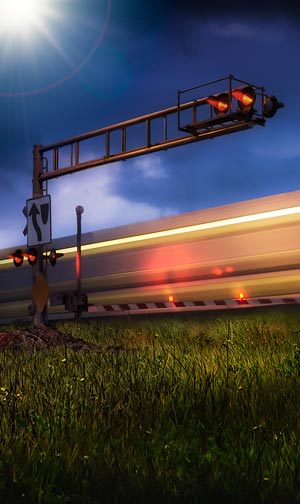(Brentwood, Arkansas – October 16, 2014)
An Arkansas & Missouri Railroad passenger train with an estimated 44 passengers on board, all planning on a sight-seeing trip through NE Arkansas’ Boston Mountain region to view autumn colors, stalled on an incline south of its departure point of Bentonville, AR, only to have a relief locomotive, sent from Chester, AR, north of the railroad’s operating terminal at Van Buren, AR, run head-on into the front of the stalled train as it rounded a curve on the non-signalized railroad Thursday morning at about 10:30 A.M., CDT. The collision injured at least 44 passengers and train crew members as both train’s locomotives derailed and the crash came as the relief train slid into the stalled train on the same descending track that had precipitated the stall.
According to A&M Railroad Police Chief Ron Sparks, the operators of the relief locomotive were unsure as to the exact location of the stalled passenger train, and ran into it as they rounded a curve. Speed limit on the track where the crash occurred is 35 mph.
Sparks also blamed the passenger train’s inability to climb the grade upon which it stalled on wet, fallen leaves which prevented adequate adhesion between the locomotives’ powered wheels and the rails.
The National Transportation Safety Board dispatched its “GO” team from its Washington, DC. Headquarters to the scene, arriving in Fayetteville, AR about 6:00 P.M., CDT, Thursday evening. NTSB’s Rosekind explained that the stretch of railroad where the collision occurred is “dark territory,” where communications between trains can be difficult. Since all the locomotives involved derailed were equipped with “event recorders” and forward-facing video cameras, officials involved in the investigation should have a wealth of information available to them.
Although a copy of the operating rules manual under which the A&M operates was unavailable, traditional railroad rules emphasize that, in the case of stoppage, flagmen are to be sent a sufficient distance before and behind the stopped train to prevent such an occurrence as happened Thursday.
The NTSB has long advocated early installation and launch of a satellite-based train-tracking system called Positive Train Control, which over-rides human operation of trains carrying passengers, hazardous materials, etc., and which has been mandated by Congress for full installation by next year. But lobbyists from the nation’s major railroads have requested an additional five-year delay to activation of the system which surely would have lessened, if not prevented entirely, Thursday’s tragedy.
The injured, some termed to be in “critical condition”, were taken to area care centers, including Washington Regional Medical Center in Fayetteville, Northwest Medical Center in Springdale, and Physician’s Specialty Hospital in Fayetteville.
A&M Passenger Train Operations Manager Brenda Rouse said that the incident was under investigation, but offered no further comment to news media inquiries.
The railroad’s website states that “In 1990, the A&M commenced its passenger excursion service as a means to enhance tourism and community relations.”
The Arkansas & Missouri Railroad was created in 1986 as a Class III railroad, first leasing and finally completing the purchase of the 150-mile-long rail route between Monett, MO and Fort Smith, AR, with corporate headquarters in Springdale, AR. The rail line was originally constructed in the 1880’s by the St. Louis-San Francisco (“Frisco”) Railroad, and became part of the Burlington Northern (now BNSF) system through merger in the early 1980’s. The railroad’s website also boasts of having a “system (which) visually documents upcoming railroad crossings. Train whistles, bells, crossing signals, and radio traffic from the engineer, crew and dispatcher are also taped with a voice recorder in the system. The system can record activity up to one hundred yards ahead of the train’s path and traffic on either side of an upcoming crossing. Material that is collected from this technology will serve as evidence in the event of a crossing accident as well as serve as an educational tool in presentations to the public. We recently finished installing upgraded cameras on all lead locomotives.”
A&M’s Board Chairman, J. Reilly McCarron, is also a member of the railroad industry founded and primarily funded Operation Lifesaver, Inc. organization, which basically faults motorists for crossing collisions.
The Washington County location of the collision was only a short distance and a county line (Crawford County) away from the site of a serious derailment on the A&MRR October 9, which resulted in the derailment of three locomotives, two of which turned over on their sides, and recordable injury to two crew members. That accident was blamed on washed-out track.
The extremely-busy U.S, Highway 71 was completely closed in both directions for at least three hours Thursday as emergency vehicles blocked the somewhat-parallel four-lane route.


